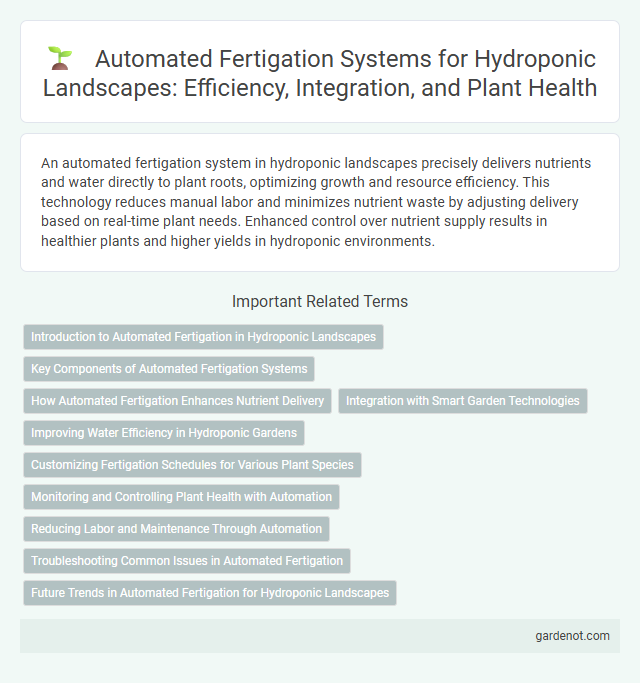An automated fertigation system in hydroponic landscapes precisely delivers nutrients and water directly to plant roots, optimizing growth and resource efficiency. This technology reduces manual labor and minimizes nutrient waste by adjusting delivery based on real-time plant needs. Enhanced control over nutrient supply results in healthier plants and higher yields in hydroponic environments.
Introduction to Automated Fertigation in Hydroponic Landscapes
Automated fertigation systems in hydroponic landscapes precisely deliver nutrients and water directly to plant roots, enhancing growth efficiency and reducing resource waste. These systems integrate sensors and controllers to monitor pH, electrical conductivity, and moisture levels, ensuring optimal nutrient balance tailored to specific plant needs. Implementing automated fertigation technology significantly increases crop yield, reduces labor costs, and supports sustainable water and nutrient management in controlled environment agriculture.
Key Components of Automated Fertigation Systems
Automated fertigation systems in hydroponic landscapes consist primarily of nutrient reservoirs, dosing pumps, flow meters, and controllers with integrated sensors for pH, electrical conductivity (EC), and temperature. These components work in synergy to accurately deliver precise nutrient and water mixtures tailored to specific crop requirements, ensuring optimal plant growth. The integration of real-time monitoring and feedback loops allows continuous adjustment, minimizing nutrient wastage and maximizing resource efficiency.
How Automated Fertigation Enhances Nutrient Delivery
Automated fertigation systems precisely regulate the timing and concentration of nutrient delivery in hydroponic landscapes, ensuring optimal plant growth conditions. By integrating sensors and real-time data analytics, these systems adjust nutrient solutions based on plant requirements and environmental factors, minimizing waste and preventing over-fertilization. Enhanced nutrient uptake efficiency leads to healthier crops, higher yields, and reduced operational costs in controlled environment agriculture.
Integration with Smart Garden Technologies
Automated fertigation systems seamlessly integrate with smart garden technologies to optimize nutrient delivery in hydroponic landscapes. Sensors monitor plant health and environmental conditions, enabling precise adjustments to water and nutrient supply in real-time. This integration enhances growth efficiency, reduces waste, and supports sustainable urban agriculture practices.
Improving Water Efficiency in Hydroponic Gardens
Automated fertigation systems in hydroponic gardens optimize nutrient delivery and significantly reduce water waste by precisely controlling the timing and flow of nutrient-rich solutions. Advanced sensors and smart controllers adjust water application based on real-time plant needs, minimizing runoff and evaporation. This technology enhances water efficiency up to 40% compared to traditional manual irrigation methods, promoting sustainable hydroponic crop production.
Customizing Fertigation Schedules for Various Plant Species
Automated fertigation systems enhance hydroponic landscapes by precisely customizing nutrient delivery schedules tailored to the growth stages and specific requirements of various plant species. Advanced sensors and AI-driven algorithms monitor plant health metrics, adjusting nutrient concentrations and irrigation timing to optimize growth and yield. This targeted approach reduces resource waste, improves plant vitality, and enables scalable, efficient hydroponic cultivation across diverse crops.
Monitoring and Controlling Plant Health with Automation
Automated fertigation systems integrate sensors and data analytics to precisely monitor nutrient levels, pH, and moisture in hydroponic landscapes, ensuring optimal plant health. Real-time adjustments in nutrient delivery and water flow reduce human error, enhancing growth efficiency and minimizing resource waste. Advanced control algorithms optimize the fertigation schedule, promoting consistent development and early detection of plant stress or disease.
Reducing Labor and Maintenance Through Automation
Automated fertigation systems in hydroponic landscapes significantly reduce labor and maintenance by precisely delivering nutrients and water directly to plants, minimizing manual intervention. Advanced sensors and control units monitor plant needs in real-time, optimizing resource use while preventing over- or under-feeding. This automation streamlines operations, enhances crop health, and lowers operational costs, making hydroponic cultivation more efficient and sustainable.
Troubleshooting Common Issues in Automated Fertigation
Automated fertigation systems in hydroponic landscapes often face common issues such as pump malfunctions, clogged emitters, and nutrient imbalances, which can disrupt plant growth. Regular inspection of pumps, cleaning of drip lines, and calibration of nutrient sensors ensure optimal system performance and consistent nutrient delivery. Implementing real-time monitoring tools and automated alerts helps quickly identify and resolve faults, minimizing downtime and maximizing crop yield.
Future Trends in Automated Fertigation for Hydroponic Landscapes
Future trends in automated fertigation for hydroponic landscapes emphasize integrating AI-driven sensors and data analytics to optimize nutrient delivery and water efficiency. Advanced systems leverage real-time monitoring of plant health, environmental conditions, and growth stages to precisely tailor nutrient formulas, reducing waste and enhancing yield quality. Emerging technologies also focus on remote management and predictive maintenance to ensure consistent performance and minimize labor costs in large-scale hydroponic operations.
Automated fertigation system Infographic

 gardenot.com
gardenot.com